Picture Pages: Final Bubble Treatise

Complaining about the lack of bubble screens in Michigan's offense has become a hobby-horse here. Some people find this weird. I admit that a focus on one particular play, no matter what it is, is often missing the forest for a tree, and my focus on a play that picks up eight yards if run well is a little maniacal. But I see a lot of things not work and think 1) the bubble is open and 2) that might have worked if the bubble wasn't open.
While the bubble seems like an option you can take or leave, it's actually a key way to make every player on the offense an effective blocker every play. When Magee goes to his cutups in those videos about the spread 'n' shred philosophy, the guy asking most of the questions* wants to see bubbles first.
*[who I think is Harvard's coach since he talks about playing Columbia and a pizza place on "Comm Ave" that Google reveals is in Boston.]
The bubble is a constraint that opens up other things and forces the defense into positions it would rather not take. Michigan saw this first hand, as a series of first half bubbles forced Jake Ryan into the slot against Northwestern. Even that wasn't enough to hold down the single bubble the Wildcats ran in the second half before fumbles and interceptions and Michigan scoring on every drive terminated Northwestern's ability to use them.
It's not just a play. It's part of a coherent whole. Spreading the field stresses the defense only if you make the D cover everyone horizontally. Smart Football explained a long Oregon touchdown in the recent Stanford game and I was struck by the difference between the way Stanford defends this play…
…and the way Illinois defended a similarly unbalanced formation from Michigan:
That is a similar setup with one extra guy in the backfield. The highlighted defender to the top of the screen is the equivalent of #3 at the top of the Stanford defense (not the guy on the line)… unless the highlighted guy at the bottom—the corner—is. Someone on this defense is not respecting the threat of Junior Hemingway.
Michigan will run the play I've been calling "inverted veer", which is probably not the best terminology since various people say people call it "dash" and since it features a guy pulling to the frontside of the play it's not really a "veer"—if you care about these things. It's too late for me since I've got a tag, but you can still save yourself.
Anyway, on the snap, before the mesh point, it is clear that both highlighted defenders are going to get involved in the run defense.
Where is the equivalent guy in the Stanford play?
His feet are the ones bugging out for the bubble at the top of the screen. This effectively blocks a defender without having to engage that receiver's potentially crap blocking skills.
Junior Hemingway's existence, in contrast, is pointlessly lonely:
There isn't anyone within five yards of him by the time the mesh point passes. Even before the mesh it's clear the bubble is going to be open, if it was being run.
Anyway, at the mesh point the containing DE is containing so Denard pulls.
This options off a DE; the slot guy is being taken by Hopkins; the playside LB will get kicked by the pulling Omameh. There is no one for the corner, and this has turned into a run up the middle.
This is pretty much dead at this point. Michigan's got some problems on the line, too: you can see that the Lewan/Schofield combo block hasn't even sealed the playside DT, let alone the WLB… but that's just another reason the play isn't going to work since Denard is tackled in the backfield by that backside CB:
Pile of bodies, no gain, third down.
Video
Items of Interest
This isn't to say I think Borges did a bad job in this game. I did get a little frustrated by the forays into the I that were spectacularly unsuccessful—before the Toussaint runs in garbage time Michigan had run seven times out of the I for –1 yards—and the lack of responses to the increasingly aggressive Illinois defense. HOWEVA, in context the move was to go conservative and get out of Dodge; before that was the move he tore up a good defense and was thwarted largely by things out of his control.
There are multiple issues with this play and I'm not suggesting the bubble is a panacea. I am saying it is going to work for tons of yards here, but it's not the only reason this play gets thumped.
The threat of the bubble effectively options off another defender. This means more space for people who are good in space, one more opportunity to blow something for the defense, and mitigates the following.
Receivers' blocking eh… not so good. On the play where Denard fumbled he actually had a good setup for the pull: the backside DE has shuffled down the line and Koger went around him to the edge.
Unfortunately, Junior Hemingway's consistently crap blocking reared its head on this play and the slot LB—who is actually covering the WR on this play—created problems.
Denard has to cut back. If Michigan's running a bubble this guy is either outside of the hash or Denard's throwing it to Hemingway or the Illinois defense is getting super aggressive and opening itself up to a Worst Waldo play. Since he's just a wide receiver who can't block Denard loses an opportunity to burst into a ton of space.
Lack of bubbles = lack of big plays (that aren't chuck and hope)? If you're looking for a culprit when it comes to the lack of long plays that are very open, the lack of the humble bubble screen is a candidate. When you spread the field and make the defense defend all eleven players on every play, a single breakdown means big yards. If you're covering every WR man to man and trying to leave two deep safeties, this is the result:
Michigan has put a lot less stress on safeties this year because they run a bunch of plays from a formation in which opponent safeties think "if they run it will be for half a yard" and when they're in the shotgun they aren't really in the spread, if you catch my drift. By not attacking the outside consistently Michigan lets opponents defend them with two deep.
In the inverted veer above the guy on Hemingway starts 13 yards off the LOS, which means the free safety can come down on the run without worrying about an Oh Noes.
Also bubbles work, yo. I mean, sure, opponents freaked out about them in the RR era since they were a foundational component of the offense but when they were run they worked, and when opponents run them against Michigan (or State vs Iowa) they pick up chunks. When you can get a chunk on first down you have a low-pressure environment to probe with your run game.
This is clearly a philosophical thing that is permanent. I'll drop it now, and this is not a criticism of Al Borges's overall philosophy—we have no idea what that's going to be like. It's clear, however, that the vast bulk of teams who use the quarterback as a runner believe the bubble is an integral part of the effectiveness of the offense. Michigan doesn't, and unless Borges can explain that in a way better than "don't ask me about it" its absence will rankle.
November 16th, 2011 at 1:29 PM ^
November 16th, 2011 at 1:45 PM ^
Depending on how old it is, could be Northeastern, who cancelled football a couple of years ago, and is right on Commonwealth
edit: misremembered, its sorta close to comm ave, not on it
November 16th, 2011 at 1:37 PM ^
Here's a link to the article in Wikipedia.
November 16th, 2011 at 1:31 PM ^
Quick question - in one of our recent games (Iowa?) it looked like we made an adjustment where the slot receiver would run a quick out against that type of formation. When run, it looked like a "QB Oh Noes" but instead of hitting a WR (or TE) running down the seam the throw went to the slot receiver running a 5-yard out against a defender playing way too far inside (as in your pictures). Did you notice this, and if so, do you think that play was Borges' attempt to make the defensive alignment a little more honest?
(If so, it clearly didn't work, as the Illnois defensive alignements above demonstrate).
Thanks!
November 16th, 2011 at 1:44 PM ^
Teams were adjusting how they came crashing down and kept people to cover the deep "oh nos" play. RR adjusted by having the defender run essentially a 5 yard out or so. Still effective, but not nearly as big of a play.
November 16th, 2011 at 1:36 PM ^
Does this have anything to do with, what seems to be, a lack of a short passing game? I really think that having Koger or Smith leak out into the flat gives Denard or Devin an easy oulet pass.
November 16th, 2011 at 1:38 PM ^
Vs neb or osu with an out of nowhere bubble screen, we should carry brian off the field on our shoulders.
November 16th, 2011 at 1:51 PM ^
Brian doesn't play football or coach for Michigan. You'd be carrying him out of the stands on your shoulders, which would be interesting given the stairs you'd have to traverse.
November 16th, 2011 at 1:59 PM ^
Carry him onto the field?
November 16th, 2011 at 2:02 PM ^
After Brian rushes the field with the rest of the crowd following a Nebraska and OSU victory, Brian would get carried off the field.
November 16th, 2011 at 2:20 PM ^
You're going to rush the field after beating a 6-5 Ohio State team?
Shamone.
November 16th, 2011 at 2:21 PM ^
then our transformation into MSU of the 90s would be complete!
seriously, I'm wagging my finger at you fanbase. Grow up.
November 16th, 2011 at 2:28 PM ^
You think that OSU is going to lose to PSU at home?
ShamWow.
November 16th, 2011 at 4:02 PM ^
OSU rushed the field after beating Michigan in 2008. Admittedly, it was more of a "carefully-move-onto-field" than a rush persay, but still. I'd expect at least a few fans to want to stand on the field and celebrate if Michigan ends the drought against Ohio State, even if they were 0-12.
November 16th, 2011 at 1:45 PM ^
Do you think Borgess doesn't want to deploy the bubble or talk about it because he is saving it for the osu game?
November 16th, 2011 at 1:50 PM ^
...a valid point I got back is that this isn't really a play that one saves for a big game--it won't break out for massive yards. I wonder if it's held in reserve, however, so that we don't have to show the next play we'll run to counter the response to the bubble. Perhaps Borges is two steps ahead. He'll run the bubble early vs. OSU, OSU will respond, and then WHAM! we run the extra-special dippity-do play that will work perfectly against a D covering the bubble. THAT's the play he doesn't want to show(?).
Okay, I can dream.
November 16th, 2011 at 1:51 PM ^
I think that explanation is borderline insane.
November 16th, 2011 at 1:59 PM ^
Apparently you're not familiar with high profile, successful football coaches. To say "they're a different breed" it to put it nicely.
November 16th, 2011 at 2:01 PM ^
I REALLY hope he's not saving the bubble screen for the Ohio State game, especially since it's not like it's an incredibly-complex wrinkle to introduce to our offense (given that they ran it last year plenty).
I can't fathom that Borges would keep the bubble screen in the playbook when using it could have slowed down MSU's blitz pressure or helped Michigan move the ball against Iowa (before the final 3 drives). Since I'm assuming that Borges is entering each game using a gameplan he thinks gives Michigan the best chance of winning, I also have to assume that Borges simply does not like to use bubble screens... at least this year.
November 16th, 2011 at 2:29 PM ^
I really wish Borges would give us a real answer on this one. It baffles me, because he's been flexible elsewhere with playcalling - why would he be willing to run zone reads but not bubble screens? Brian suspects that "it's just not part of the offense", but why not when we've seen just about everything else?
The bubble screen is a ridiculously simple play, we have the perfect guys to run it, and it addresses a fundamental shortcoming of this year's offense: inability to threaten the edges and force defenses to respect our WRs on running downs. That final point is what's most worrying to me. I'd be totally fine with not running the bubble if we had another staple play that served the same purpose - but we don't. As a result, teams can sell out against the run, and we don't punish them for it.
Just think how much easier our short yardage running game would be with the bubble (or an equivalent) as a threat. Sell out against the run on 3rd and 2? BAM bubble screen for 5-10 yards. Respect the bubble on 3rd and 2? BAM Touissant or Denard run for 3.
The real crux was mentioned by Brian - we're running plays from shotgun, but we aren't running a "spread" because we aren't spreading the defense. Running zone reads without a bubble threat is like running power without pulling a guard - you're sacrificing the fundamental advantage of the scheme. It causes the "10 man football" that's been talked about by the coordinators - if one guy isn't perfect, the play is a disaster. Spreading the field would not only yield better results when everything goes right, it would reduce the cost when something goes wrong.
November 16th, 2011 at 2:45 PM ^
I'd hate to think we're leaving these free yards on the table (not to mention how it loosens everything else we'd do) out of some kind of principle that it's a dumb play. Or something. There's just no good explanation.
Hopefully Borges is just clever like a fox and there is a damn good reason.
November 16th, 2011 at 2:52 PM ^
Actually, it's more like running power football without a strong play action threat. If you want to equate power running without a pulling guard to zone reads, it would be zone reads without leaving the DE unblocked.
November 16th, 2011 at 4:07 PM ^
Interesting that you bring up that analogy since Borges also runs power football without a strong play action threat this year.
November 16th, 2011 at 3:48 PM ^
I wish someone would demand Borges explain why he doesn't use the triple option. I also wish someone would demand why he doesn't use the fullback dive more often.
Some people on this site persist in thinking Michigan's offensive coordinator should be viewed as a judge on American Idol. "We like this and want to see it! In our judgment it will work in your or any offense! Therefore, you should do what people on Mgoblog say you should do, or else justify yourself to us!"
November 16th, 2011 at 2:50 PM ^
I'm not sure if Borges will use it against NE but he may use it to help the offense to blow out OSU and also in our bowl game.
Here's hoping the offense continues to play well and is able to score more TD's in the redzone!
The way the defense is playing, if the offense ever did get red hot this team would be unstoppable.
November 16th, 2011 at 3:05 PM ^
To me, its less about that specific play and more about why Borges responded the way he did. Either he wanted to stop the talk because he is planning on breaking it out sometime, or he was truly insulted by the question. If he's not planning to ever employ the bubble screen, why be insulted by a question as to why? Answer the question once and be done with it. Its the perfect chance to educate the under-educated. It just seems like a very strange answer which then spawns gossip/more questions.
November 16th, 2011 at 3:15 PM ^
Maybe he takes it as second-guessing his offensive philosophy in general. I can see where he would take offense to that, but I agree that if he would explain the philosophy behind not using it he would likely eliminate the "second-guessing". OTOH, if he gives reasoning and someone disagrees with the reasoning, it invites more questions and second-guessing. Also, saying he doesn't like the play for one reason or another eliminates the threat of him pulling it out of the bag and the opposing defenses are less likely to worry about that particular play, even if he doesn't ever plan on using it.
November 16th, 2011 at 3:06 PM ^
Just a thought, has Denard demonstrated the ability to make the proper read and throw the bubble with the proper timing & accuracy? IMO he has not mastered tthe zone read play yet let alone the 3rd option(bubble).
Maybe I'm wrong and resident spread experts can correct me, but I've yet to see him(including RR days) really run that staple as effectively as the list of many others we see doing it every saturday. Sometimes it looks to me as if Denard has made up his mind whether to keep or hand off before the snap rather than actually "reading", or does he just make the wrong read alot??
Like I said, I could be wrong, this is not data driven but more a visual observation mostly from watching other teams run similar plays.
November 16th, 2011 at 3:12 PM ^
I don't think RichRod ever had the bubble as a read. It was called from the sideline only.
I think Magee allows bubble reads but not RichRod.
I'm with you on not remembering the bubble as this awesomely amazing play from last season either.
November 16th, 2011 at 3:21 PM ^
We did use it as a 3rd option on the read option. I think it was one of our options for countering the scrape exchange. If the DE crashes on the RB and the Will is taking the QB, theoretically, the slot is open with no one on him. Essentially, we used it in situations almost identical to this one, except we were more spread out before.
November 16th, 2011 at 3:20 PM ^
1) Can Denard throw it accurately? Play sucks if the ball isn't thrown where WR can catch in stride.
2) Can you block it effectively? Play really sucks if Corner beats #1 and jacks up the WR catching the ball. With cut blocking into the formation now illegal, can make it hard for #1 to make block if Corner slices in on bubble look.
3) Harder to teach than it looks. When run well, it's an excellent play. When run poorly, it looks like garbage. Either it's part of what you do or it's not. Would have to practice it daily, particularly out of multiple defensive looks for blocking purposes.
4) Not a good answer to any man coverage.
I'm sure there are other reasons as well, but the gist is that there is a lot more good stuff out there on offense and defense than coaches have time to teach effectively.
November 16th, 2011 at 3:42 PM ^
1) I think everyone can agree on this, but it doesn't sound like they are even willing to give Denard a chance to attempt to throw it.
2) If the corner bites on the bubble that hard, then it leaves your outside receiver wide open down the sideline or, at the very least, 1-on-1 with a safety allowing the receiver to choose a fly route or a post. Either way, that gives you the big play opportunity that Borges should be looking for.
3) I probably have to agree with this and can't really refute it, but you already have to practice WRs blocking in any case. Really, it would only be necessary for Denard to practice the throw, which goes back to #1.
4) That's not true. A lot of times a safety will be in man over the slot if the LB would be blitzing. This would burn that man coverage to a crisp.
In this particular case, I don't agree that a bubble is a great idea. If the LB doesn't blitz then the slot is covered. If the LB does blitz, then he is right in the throwing lane that Denard needs to get the ball to the slot. I think what this all boils down to, though, is that Borges doesn't want to run it because it's not part of his system, which is fine. If he feels there are better options, that's fine, but he's not using them, which is the troubling part.
November 17th, 2011 at 12:22 AM ^
1) I trust Denard to make this throw, than throwing 30 yard bombs down the feild into double coverage.
2) You missed the point Brian made. If you throw the bubble off the zone-read, you're taking away a defender (who is playing run) so the blocking doesn't have to be as *perfect* as say a pulling guard on a power run.
3) It may be harder to install than it looks, but it's a hell of a lot easier to install than sight adjustments that we are currectly trying to implement.
4) If they're playing straight man outside, that's advantage run game. That's one less person off the edge crashing on Denard.
Like Brian said, it's not a panacea. But if the defense is giving it to you, you should take it. Instead of trying to force your play into the defense's strengths. And just the threat of it, will loosen the defense on what you really want to do which is have Denard/Fitz run it 50 yards untouched.
November 16th, 2011 at 3:23 PM ^
Did Borges run bubbles at SDSU or Auburn? If not, then we can probably forget about it. If so, then we have to wonder if its just something with Denard or the receivers.
What are the negatives with it? Small chance of an INT off a tipped pass, a backward pass/fumble?
November 16th, 2011 at 3:43 PM ^
The reason Michigan isn't getting more big plays is a lack of bubble screens? Is that "constraint" a play in big plays, as such? I MUST be reading wrongly, because it sounds absurd to say Michigan is not getting more big plays because they are not running bubble screens.
The bubble screen "isn't just a play. It's a coherent philosophy." Well, maybe Borges doesn't embrace that philosophy. To then fault him for not using bubble screens amounts to rejecting his offensive philosophy. If you reject his offensive philosophy, that implies some disapproval. So, in effect, you keep banging this drum because you wished Borges ran RR or Oregon's offense.
Nothing new here...
November 16th, 2011 at 3:44 PM ^
It seems to me he has been pretty candid about answering all other questions, so I wonder why it hits a hot button? Maybe there is something going on that he does not want to tell us????
November 16th, 2011 at 4:00 PM ^
The person who doesn't get his block executed is Schofield (#75). He's hitting the DT with Lewan (#77), and then scraping off at the WILL, and failing. And the WILL makes the tackle for a 1 yard gain. If the WILL doesn't make the tackle, Denard is through one on one with the Deep safety, who may get blocked by Junior. The Nickleback/Slot LB is taken care of by #33, and the DE that Moore (#89) let through for some reason, seems to be the optioned DE that Denard is reading. So I think the TE is supposed to let the DE through, the backside Corner is too late to do anything, so he's the unblocked defender where the offense is gaining leverage. So I don't think Hemingway does anything wrong, since with two RB's back, the Slot LB (who is either the SAM or the Nickelback) will be taken care of, and the DE crashing in has to choose. Omameh is pulling and takes care of the MIKE. So from the design of this play I think it still accounts for every defender, PLUS gaining an advantage of extra downfield blocking since Hemingway and the TE Moore are both heading downfield for second level/third level blocking. IF the strong side guard could just slide off the DT block and get to the WILL, then that's a massive size advantage. But Illinois apparently has a pretty intelligent WILL, since all the flow of the RB's and QB is to the strong side and he crashes there immediately. But since he's starting where Omameh starts, you would think that Schofield could still just head straight out to stop a guy 3-4 yards to his right.
I think the schematic analysis should start from a position that assumes Borges is NOT running RR's offense despite the similarities in alignment. Also maybe there is an option/check down to throwing to Hemingway on a slant route. What's interesting is that the WR who is on the line of scrimmage ends up making the TE (#89) inelligible since the TE is covered, and the weakside tackle is an eligible receiver in this specific formation. I think Brian pointed out before that this should tell the defense it's likely a run, since the TE isn't eligible, BUT Hemingway is, since he's lined up behind the line of scrimmage. So whether you call it a bubble or not, this play would have worked if Schofield got his block, and would have worked for long long yardage for Denard. Additionally Denard could have thrown to Hemingway, and maybe that is the option that just wasn't called on this specific play since Borges wanted to make sure the defense saw the first option.
In any case, on this play, the highlighted defenders do not make the tackle, and they are not blocked by someone who could have blocked the WILL who did make the tackle.
Also this play demonstrates that Omameh must have learned how to pull because he destroys the MIKE on this play.
EDIT - ok I missed the fact that the weak side CB makes contact with Denard first. So it's the weakside CB and the WILL who make the tackle. There is not one for the backside CB, so either this play hopes that everything happens faster than it really does, or it's a poor play formation from the start. What I'll say about Borges is that it's very likley he understands the Read Option theories, but he does not have the experience with it to coach it at the same level as Rodriguez. So he is learning Read Option as much as Denard is learning Pro-Style-West Coast. Where I take comfort is that Borges did describe the Fitz run as a success because the defenders where keying on Denard. So Borges does get it about Denard and last year, but just does not have the same system experience.
November 16th, 2011 at 4:33 PM ^
In several of his pressers, Borges has made reference to various plays in his offensive as making other plays possible. Perhaps the bubble does not do that in his system. Or perhaps it is a preparation issue. I ASSume that plays are practiced so that the progression feeds off the previous play. You start with a base and then practice the various extrapolations. Perhaps, in his system, prepping the bubble would be too expensive compared to other choices.
In listening to him he seems to never consider any play in isolation. It may be that, in and of itself, he has no problem with the bubble, but it doesn't fit with what he is trying to coach this particular team to do.
Borges doesn't really tell us much about how his plays support each other in his system. I would not expect him to comment on whether or not the bubble fits or why.
November 17th, 2011 at 11:12 AM ^
I suppose bubble screens are best for QBs who are tall and can see better over wall of defenders.
September 18th, 2012 at 4:14 AM ^
![grantland_e_Oregon-101jr_576[1] grantland_e_Oregon-101jr_576[1]](https://mgoblog.com/sites/mgoblog.com/files/grantland_e_Oregon-101jr_5761_thumb.jpg)
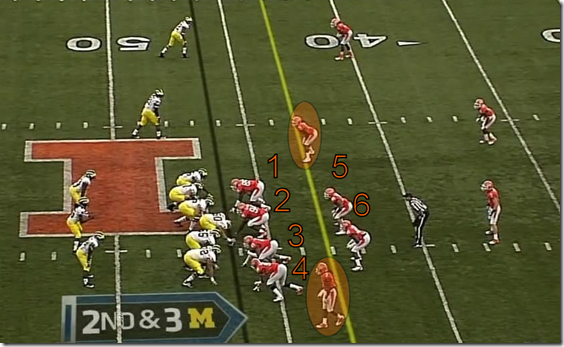
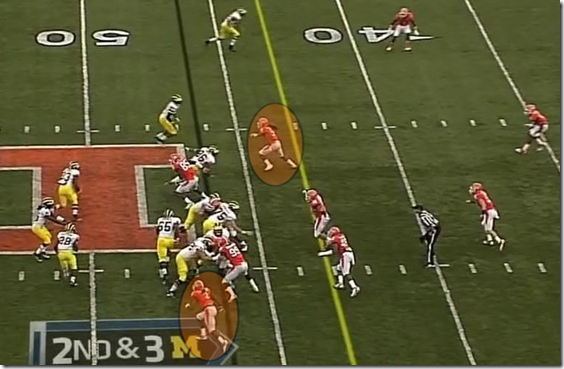
![grantland_e_Oregon-201jr_576[1] grantland_e_Oregon-201jr_576[1]](https://mgoblog.com/sites/mgoblog.com/files/grantland_e_Oregon-201jr_5761_thumb.jpg)
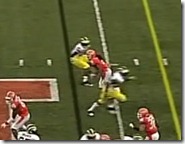
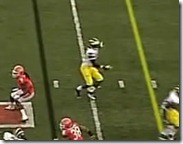
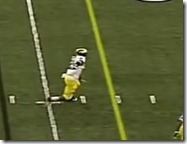

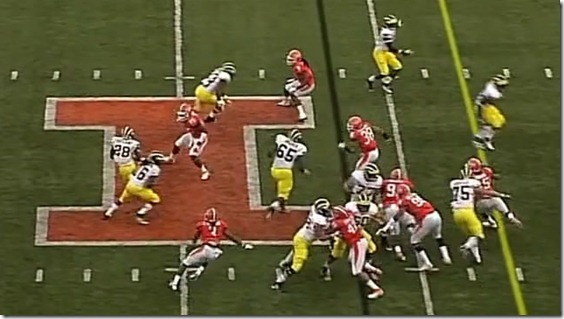
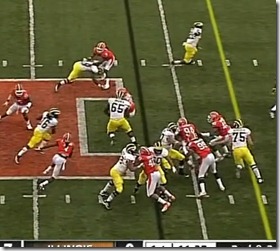

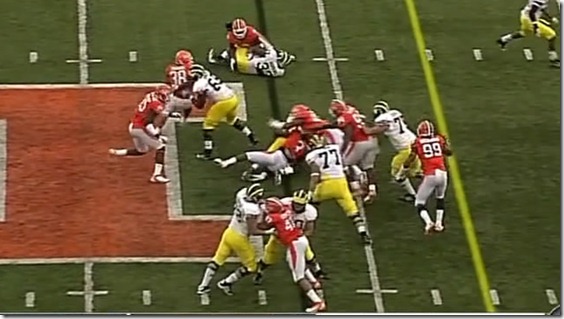
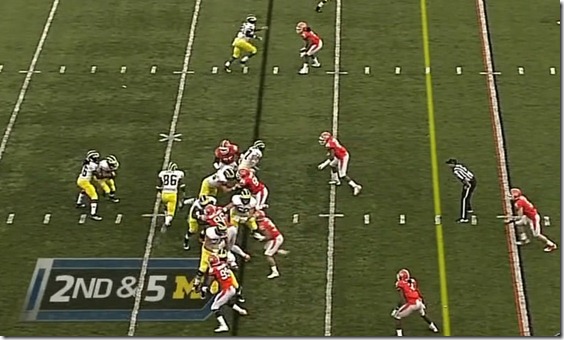
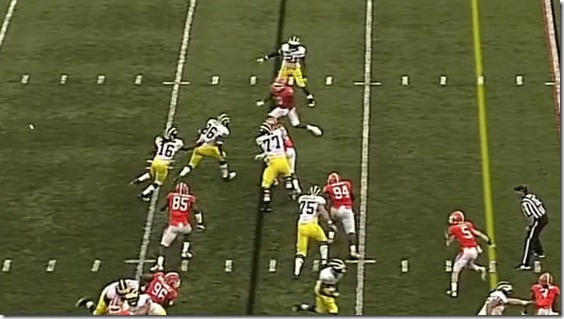
![6346037042_7a30917b96[1] 6346037042_7a30917b96[1]](https://mgoblog.com/sites/mgoblog.com/files/6346037042_7a30917b961_thumb.jpg)
![6345287519_2492ff5405[1] 6345287519_2492ff5405[1]](https://mgoblog.com/sites/mgoblog.com/files/6345287519_2492ff54051_thumb.jpg)
Comments